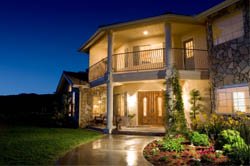|
Home: Installing Outdoor Lighting
Planning and Installing Outdoor Lighting
The landscape architect can hep you determine your soil type, recommend the best plantings for your garden, and present you with an architectural layout or perspective of your landscape drawn to scale. He may even be able to recommend a great lighting designer if you wish to go that route. I cannot stress enough how important proper planning is to your project. Just remember that doing it right the first time around will save you a lot of time and energy.
Choosing the best Outdoor Lighting DesignerOnce your layout is set, you can consult your lighting designer for help. A lighting designer knows the business and has a good idea of how to get whatever effect you wish to create designed to your taste.
3 Tips For Hiring A Lighting Designer
Communication It is vitally important that your lighting designer, landscape architect, and contractors communicate effectively. All lighting designs must be incorporated into the landscape after the plantings and other essential elements in your project are completed. That's because certain elements in your lighting design must be hidden in order to create a clean and finished look to your lighting project.
Extensive Knowledge Junction boxes and low voltage transformers are needed for proper operation of your lighting and should be placed in the proper locations for best results. A good lighting designer should know the proper tools of the trade needed to make the installation run smoothly. Installing outdoor lighting requires extensive knowledge of how the outdoor environment can affect your lighting system. Special cables must be used when running outdoor lighting. The lighting designer should fully understand what you want to accomplish in your lighting design and should know your budget. A experienced designer should be able to suggest alternative methods of creating the desired effect without breaking your budget too much.
Following Local LawsYour lighting designer must be aware of the local laws required when installing outdoor lighting. He must be well versed in the type of wiring needed for different applications and be knowledgeable about the proper installation process. For example, a municipality may require low voltage lighting cables to be installed at a minimum of 18" under ground and also require that it be fed through PVC piping. This of course must first be cleared with your local municipality and it's laws regarding outdoor lighting installation. Your local laws may also require that an inspection be done prior to the work being completed. Especially when installing line voltage lighting, always make sure to have an inspection done prior to finishing the job. Line voltage lighting if not installed correctly can cause serious bodily harm to anyone caught in it's path. Besides, why would you want to burden yourself with the responsibility of someone getting hurt?
Hiring a ContractorIf you're working with a lighting designer, the designer can usually recommend a contractor that they've worked with in the past. If you're hiring a contractor to do any of the necessary excavation, make sure that they are qualified to do the job. A contractor that works with or has a history of working closely with lighting designers is preferred. Better yet, choose to do business with reputable outdoor lighting companies and you won't have to worry about making a mistake.
Ask For References Ask the contractor for references, and reach out to those people for recommendations. Check your county's website, sometimes you can find a listing of contractors and electricians to see if they are licensed and if they have any blemishes on their license. Speak with friends and ask them for referrals. Your best bet is to always follow through and review the contractor's references, look them up online, and go out and see their work. Your primary goal is to find a contractor, landscape architect, and lighting designer that will work together and communicate necessary changes to the other parties involved. Without that, you will run into situations that can become frustating to deal with, prolong the process, and cost you more than you originally intended. Installing outdoor lighting should never be attempted by anyone except a seasoned professional. For any general inquiries, please feel free to contact me with any questions.
Return from Installing Outdoor Lighting to Creative Outdoor Lighting
|
FREE Newsletter Stay up-to-date with all the latest web updates, news, and outdoor lighting tips! Newsletter Form
|
|
|
|
Always consult with a licensed electrician before attempting any outdoor lighting work contained in this website.
Build your own site with Site Build It! | Copyright©2008 www.Creative-Outdoor-Lighting.com
Get your own custom template
 Before installing outdoor lighting you must plan out your site. The best way to do this is to consult a qualified landscape architect to help you design the best outdoor environment to suit your needs.
Before installing outdoor lighting you must plan out your site. The best way to do this is to consult a qualified landscape architect to help you design the best outdoor environment to suit your needs. 




